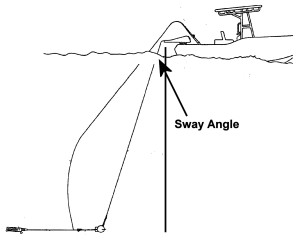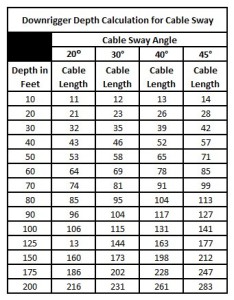by Jason Blair (for more about Jason Blair, visit www.jasonblair.net)
Fishing with downriggers is a common practice on the Great Lakes and can be one of the most productive methods of catching fish. They allow fisherman to get baits down to the depth that the fish are at and control that depth continuously. The problem is, that with currents, varying boat speeds, and cable sway, it can be very hard to determine what depth you are really fishing.
Knowing exactly what depth your are fishing at is important if you want to get your lures to the same depth as where you are marking fish. A few feet above or below the depth the fish are at can make the difference between catching fish and just spending the day washing lures.
It isn’t just as simple as reading the number of feet of cable that is out on the downrigger counter. As even the first foot of downrigger cable descends below the surface of the water (and the downrigger ball also) it begins to create drag, which make sthe downriggger cable begin to sway back. Your downrigger ball is not going to just go to the depth that matches the cable line out measurement. It will sway backward and end up descending at an angle, not straight down. This means that the number of feet measured by your downrigger isn’t actually how deep your downrigger ball is and thus, not where you are fishing.
 But is it possible to figure out how deep your bait is with a little calculation. Many will contend that this will change with current, weight of the downrigger ball, or boat speed. All of these are correct, but all of them will end up changing one variable, the angle of sway that the cable is going to experience. This angle allows us to calculate how deep our downrigger ball is by using just a little high school geometry. If we know the angle of difference between straight up and down and what the actual cable is experiencing, we can figure out what the real depth of our downrigger ball is.
But is it possible to figure out how deep your bait is with a little calculation. Many will contend that this will change with current, weight of the downrigger ball, or boat speed. All of these are correct, but all of them will end up changing one variable, the angle of sway that the cable is going to experience. This angle allows us to calculate how deep our downrigger ball is by using just a little high school geometry. If we know the angle of difference between straight up and down and what the actual cable is experiencing, we can figure out what the real depth of our downrigger ball is.
 Now, you are going to have to figure out the sway angle on your boat based on what you are experiencing on each day, but this isn’t too hard to do with a very cheap angle finder you can get at any home improvement or hardware store. With this, you can refer to the chart to the right that will let you cross reference how much line you will need to play out to get your downrigger ball to the desired fishing depth.
Now, you are going to have to figure out the sway angle on your boat based on what you are experiencing on each day, but this isn’t too hard to do with a very cheap angle finder you can get at any home improvement or hardware store. With this, you can refer to the chart to the right that will let you cross reference how much line you will need to play out to get your downrigger ball to the desired fishing depth.
Your sway angle is going to be affected by many different things, and each time you make changes, it is worth measuring again to make sure. Heavier downrigger balls will track more vertical than lighter ones. Fishing into a strong current is going to make the downrigger line pull backward and have a greater sway angle than when there is no current. And going faster or slower is going to create more or less drag and also affect the sway angle. The deeper you want to fish, the more drag the line is going to experience, resulting in greater sway angles. The good news is that it is virtually impossible to end up with a sway angle that is greater than 45 degrees unless you forget to bring your downriggers up and are under power on the way back to the dock.
Take a little time to play with the chart and get to know your boat and you will become more effective at getting your downriggers to the proper depth to catch fish.
